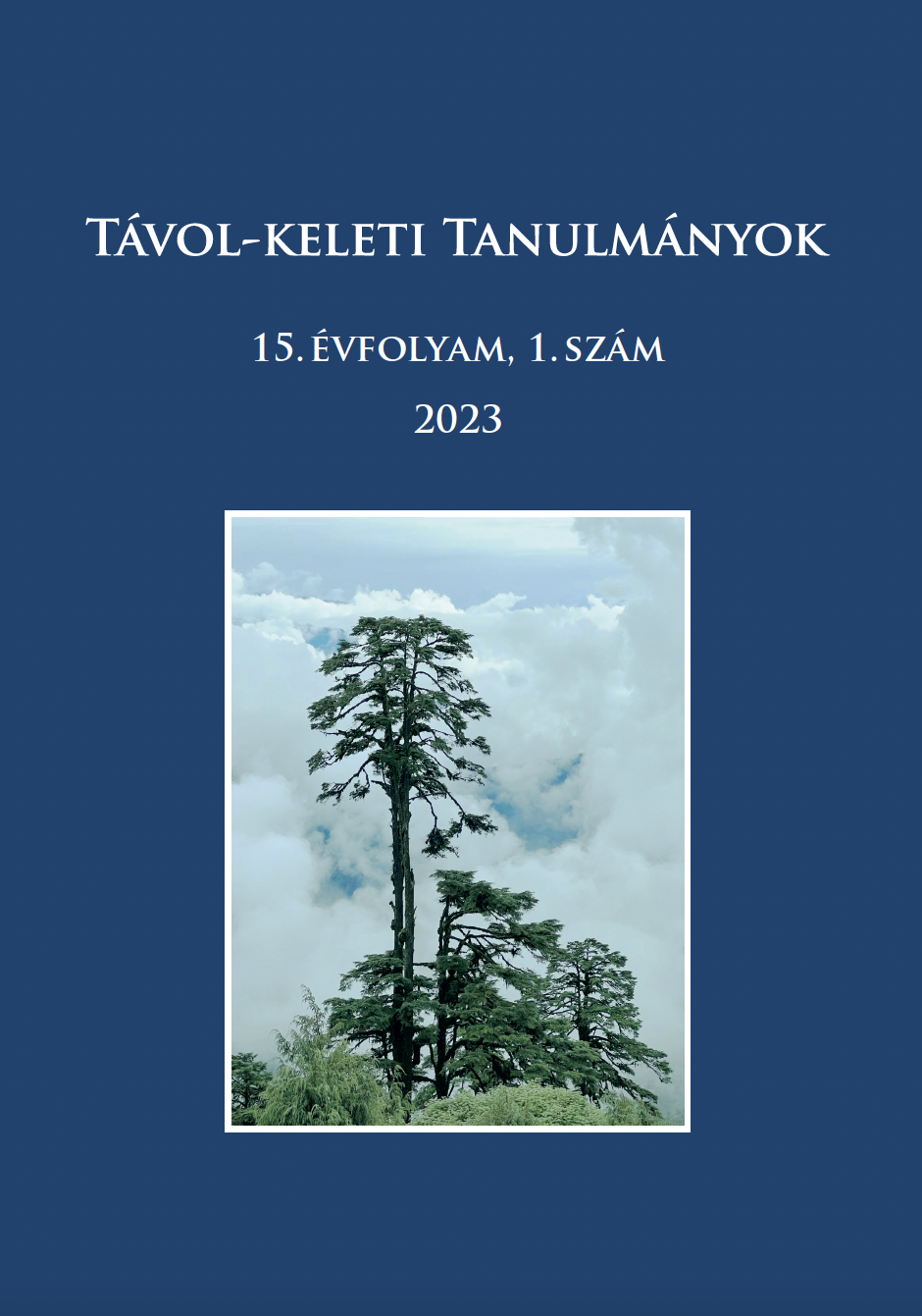A semantic analysis of huatou 話頭 in Chan Buddhist texts from the 10th to the 12th century
Published 2023-05-16
Keywords
- Chan,
- Dahui Zonggao,
- gong'an,
- huatou,
- Chinese Buddhism
- Zutang ji,
- 話頭 ...More
How to Cite
Copyright (c) 2023 Mirella Keller

This work is licensed under a Creative Commons Attribution-NonCommercial 4.0 International License.
Abstract
The Chan Buddhist term huatou 話頭 (critical phrase) denotes a Chan meditation technique. The article examines changes in the usage and semantics of huatou in different Chan texts ranging from the 10th to the 12th century.
The term huatou already appeared in the first gong’an 公案 (encounter dialogue; Jap. kōan) collection titled Zutang ji 祖堂集 (Collection from the Patriarchs’ Hall), which was compiled in 952. In addition, the article investigates another significant term, wentou 問頭, which was used similarly to huatou, denoting an essential sentence or a key question.
From the 11th century, gong’an collections started to include commentaries and later poem commentaries as well. The article examines a well-known example of the practice of writing commentaries, Foguo Yuanwu chanshi biyan lu 佛果圜悟禪師碧巖錄 (The Blue Cliff Record), compiled by Yuanwu Keqin 圓悟克勤 (1063–1135). The term huatou occurs more often in this work than in the Zutang ji, but the term still retains the same meaning and function throughout the whole collection.
The function of a gong'an collection is to evoke stories and parables mostly recording the interactions between Chan masters and their students. The article also studies the development of the usage of gong’an due to the influential teachings of Dahui Zonggao 大慧宗杲 (1089–1163), who perceived huatou as an essential unit, the key point of gong'an stories. According to his instructions, huatou performs a catalyst function for engaging with gong’an and starts to be employed as a meditation technique.
In closing, this article provides a historical overview of the development of huatou. It examines the semantic evolution of the term by showing occurrences of the term in various textual sources and discusses excerpted textual examples. Thus, it shows the historical phases of huatou in Chan Buddhism that preceded Dahui Zonggao's use of it as a meditation technique.
References
- Dahui pujue chanshi yulu 大慧普覺禪師語錄. T47, no. 1998A.
- Jingde chuandeng lu 景德傳燈錄 T51, no. 2076.
- Foguo Yuanwu chanshi yulu 佛果圓悟禪師語錄. T47, no. 1997.
- Tianru weizi chanshi yulu 天如惟則禪師語錄. X70, no. 1403.
- Wumen guan 無門關. T48, no. 2005.
- Xinxin ming 信心銘. T48, no. 2010.
- Zutang ji 祖堂集. B25, no. 144.
- Anderl, Christoph 2004. Studies in the Language of Zu-tang ji. Oslo: University of Oslo.
- Anderl, Christoph 2021. „Chán Buddhism in an Inter-religious and Cross-linguistic Perspective.” In: Christoph Anderl – Christian Wittern (eds.) Chán Buddhism in Dūnhuáng and Beyond. Leiden: Brill, 1–22. https://doi.org/10.1163/9789004439245_002
- Buswell, Robert 1987. “The ‘Short-cut’ Approach of K’an-hua Meditation: The Evolution of a Practical Subitism in Chinese Ch’an Buddhism.” In: Peter N. Gregory (ed.) Sudden and Gradual, Approaches to Enlightenment in Chinese Thought. Delhi: Motilal Banarsidass Publishers. https://doi.org/10.1515/9780824890773-011
- Broughton, L. Jeffrey ford. 2017. The Letters of Chan Master Dahui Pujue. Oxford: Oxford University Press.
- Cleary, Thomas és J. C. ford. 1998. The Blue Cliff Record. BDK Amerika.
- Foulk, T. Griffith 2000. “The Form and Function of Koan Literature: A Historical Overview.” The Koan: Text and contexts in Zen Buddhism. Oxford: Oxford University Press.
- Hamar Imre 1998. „A hirtelen megvilágosodás előfutára: Tao-seng.” Korunk 8: 76–80.
- Hamar Imre 2017. A kínai buddhizmus története. Budapest: ELTE Konfuciusz Intézet.
- Heine, Steven 2016. Chan Rhetoric of Uncertainty in the Blue Cliff Record, Sharpening a Sword at the Dragon Gate. USA: Oxford University Press. https://doi.org/10.1093/acprof:oso/9780199397761.001.0001
- McRae, R. John 2000. “The Antecedents of Encounter Dialogue in Chinese Ch’an Buddhism.” The Koan: Text and contexts in Zen Buddhism. Oxford: Oxford University Press, 46–74. https://doi.org/10.1525/9780520937079
- McRae, R. John 2003. Seeing Through Zen. California: University of California Press.
- Miklós Pál ford. 1987. Kapujanincs átjáró. Kínai csan-buddhista példázatok. Budapest: Helikon kiadó.
- Levering, L. Miriam. 2010. “Dahui Zonggao (1089-1163): The Image Created by His Stories about Himself and by His Teaching Style.” Zen Masters. USA: Oxford University Press, 91–116. https://doi.org/10.1093/acprof:oso/9780195367645.003.0004
- Pap Melinda. 2013. „A kínai buddhizmus története.” Buddhizmus. Budapest: Magyar Vallástudományi Társaság, L’Harmattan, 175–194.
- Poceski, Mario 2015. The Records of Mazu and the Making of Classical Chan Literature. Oxford: Oxford University Press. https://doi.org/10.1093/acprof:oso/9780190225742.001.0001
- Sekida Satsuki 1997. Two Zen Classics. New York: Weatherhill.
- Sharf, Robert H. 2005. Coming to Terms with Chinese Buddhism: A Reading of the Treasure Store Treatise. Honolulu: University of Hawai’i Press,
- Sharf, Robert H. 2007. “How to Think with Chan Gong’an.” Thinking with cases, Specialist Knowledge in Chinese Cultural History. Honolulu: University of Hawai’i Press, 205–243.
- Schlütter, Morten 2000. “Before the Empty Eon’ versus ‘A Dog Has No Buddha-Nature’, Kung-an Use in the Ts’ao-tung Tradition and Tahui’s Kung-an Introspection Ch’an.” The Koan: Text and contexts in Zen Buddhism. Oxford: Oxford University Press, 168–199.
- Schlütter, Morten 2010. How Zen became Zen, The dispute over Enlightenment and the Formation of Chan Buddhism in Song-Dynasty China. Honolulu: University of Hawai’i Press.
- Sun, Chaofen 1996. Word-Order Change and Grammaticalization in the History of Chinese. Standford: Standford University Press.
- Terebess Gábor ford. 1990. Folyik a híd, Zen/csan buddhista anekdotakincs. Budapest: Officina Nova.
- Wu, Jiang 2008. Enlightenment in Dispute. New York: Oxford University Press.
- Yü Chün-fang 1979. “Ta-hui Tsung-kao and Kun-an Ch’an.” Journal of Chinese Philosophy 6: 211–235. https://doi.org/10.1111/j.1540-6253.1979.tb00084.x

